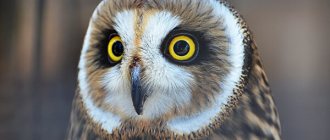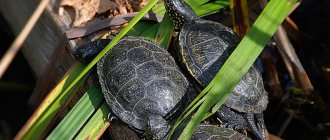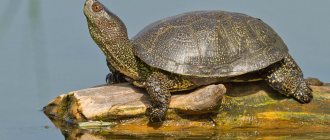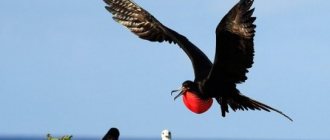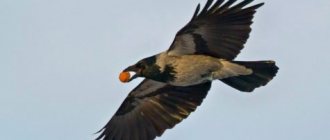Appearance of the moorhen
This small bird, the size of a pigeon, has a body weight of 192 - 493 g, a wingspan of 192 - 493 cm and a body length of 27 - 31 cm.
https://www.youtube.com/watch?v=nvdiiJt75Pc
The plumage color is slate gray or black-brown with some shade of blue on the neck. A black stripe is clearly visible on the white undertail. There are white stripes on the sides of the body. In winter, the bird's belly becomes somewhat lighter, the back and head become olive-brown. The primary flight feathers are dark gray. After the molting period, the tips of the feathers on the front of the abdomen and breast become white, which makes the plumage pockmarked.
The moorhen's beak has a triangular shape. At the end it is colored in greenish or yellowish shades, and at the base it is red. The bright red spot on the lyuba looks like an extension of the beak. The iris is colored red-brown most of the time, and only during the mating season does it become dark red. Strong and long legs with slightly elongated toes are well adapted for moving along muddy banks. The claws are slightly curved. Unlike many other species of waterfowl, the moorhen has virtually no webbed toes. Female moorhens are smaller than males, and their abdomen is painted in lighter colors.
Moorhen (Gallinula chloropus).
Young animals are noticeably different in appearance from adults. The plumage of young birds is predominantly light brown, with a somewhat grayish chest, throat and chin. Like adult birds, young moorhens have white stripes on their sides and a white undertail, but their beak is gray with a yellow tip and the red leathery patch on the forehead is not developed.
The swamp hen is an enviable and rare trophy
PHOTO SHUTTERSTOCK.COM
Perhaps some of these definitions corresponded to reality in those distant times.
It cannot be said that the hunting expert in the Orenburg province was mistaken in determining the essence of the name moorhen.
According to the modern classification, this inhabitant of swampy water bodies is included in the Grassroots family, which is a neighboring taxon with the Galliformes order.
In Central Asia, the moorhen is a common inhabitant of most fresh water bodies. The only thing that does not agree with the Russian name of the bird is its habitat in the waters of Uzbekistan, not in reed thickets, but in reed thickets and supports. There is nothing surprising here.
There are no reeds as such in the republic’s water bodies, but there are a great many areas where reeds grow. In the region, this moisture-loving cereal has no equal in its degree of adaptation to the environment.
It can grow both in a hollow near a spring in the mountains, where water barely wets the soil, and on the plain, in lakes with a depth of more than two meters. As a rule, this plant very quickly grows its vegetative part in the spring, reaching a meter in height by May.
| Hatched moorhen chicks are covered with long black down with an olive-green tint. On the head, silvery down forms a characteristic “cap”. PHOTO SHUTTERSTOCK.COM |
So the moorhen has plenty of places to hide in the luxurious reed thickets.
Swamp chicken habitats are large ditches up to two meters wide; medium-sized open collectors; small and medium sized channels with slow flow; ponds and houses; oxbow lakes in river floodplains and large lakes; reservoirs and ponds in quarries.
In addition to the dominant reed, cattail, sedge, horsetail, water pepper, susak, and hedgehog are found here.
| Due to its secretive lifestyle and low numbers, the moorhen, like other railing birds, is shot along the way when hunting waterfowl. PHOTO BY IGOR PONOMAREV |
Shallow, abundantly overgrown, small-sized reservoirs with standing water are very popular among moorhens.
These, figuratively speaking, puddles, which dry up almost completely by the end of summer, are rich in food, ranging from fresh, tender shoots of aquatic and semi-aquatic vegetation to numerous stages of insects, small crustaceans and mollusks.
With the disappearance of water, birds move to neighboring remaining reservoirs. They also feel good in large water areas. In this case, the moorhen is satisfied with the compact vegetation of bays or a narrow dense strip of reeds along the shore.
The marsh chicken's favorite feeding places are areas where hornwort and pondweed rising from the bottom of the reservoir form clusters at a distance of 10–50 meters from reliable surface cover.
Read the material “Chasing ducks without a dog”
On these “plantations,” both the leaves and buds of the apical shoots that reach the water surface, as well as the small organisms of the aquatic environment that huddle on them, are eaten. Perhaps one of the reasons for the start of migration of moorhens in the pre-winter period is the “laying of the cords” of the above-mentioned plants on the bottom.
It is then that the birds are deprived of their main food and main feeding areas. Birds like to visit open feeding areas in the early morning hours or before evening twilight.
This is especially true for bodies of water, where people are common disturbance factors. At the slightest danger, moorhens swim, or even run across the water surface, rushing towards the nearest thickets (this or that reaction depends on the degree of danger.)
It should be noted that Gallinula chloropus knows the features of its territory very well. Hunters who have tried to hide moorhens on a pond abundantly overgrown with reeds will not let them lie.
As soon as you break through to open water, it’s all over. Of course, sometimes you will have time to accompany disappearing targets with your guns at maximum range - and that’s all. Peace and quiet in the water area that had just teemed with birds. Yes, dear hunters, where the disturbance factor is minimal, the moorhen is active all day.
Like other aquatic birds, the marsh hen digests food very quickly, which encourages it to live an intensive life. Of course, her existence is complicated by her enemies. The man with the gun is one of them. And among the feathered predators on the reservoirs of Uzbekistan, the main consumer of moorhens is considered to be the marsh harrier. And swamp chickens always remember this.
For more than thirty years, visiting water bodies, I met harriers hovering above the reeds. Most often I saw the hasty flight of swamp chickens to cover and only a few times the facts of an attack.
But the death of a moorhen in the claws of a winged predator is certainly not uncommon. Of the 6–8 chicks hatched, most do not survive to fly south. In September - October, while walking along a pond, adult parent hens are usually accompanied by two, rarely three young birds. Members of the moorhen family stick together for a long time.
| The main habitats of the moorhen in Uzbekistan are associated with natural or artificial reservoirs, with banks overgrown with reeds, sedges and other semi-aquatic plants. PHOTO BY IGOR PONOMAREV. |
According to the observations of zoologists and hunters, young swamp chickens begin to migrate south at the same time as their parents. All data on this species indicate that Gallinula chloropus on the territory of the republic is a migratory bird, prone to moving at night.
The flight altitude is low, the moorhen is a mediocre flyer. Mountain ranges and spurs are excluded during the flight.
Most likely, the bulk of birds follow the plains and foothills, from reservoir to reservoir. As stated in the multi-volume work “Birds of the USSR,” “the seasonal movements of moorhens have not been sufficiently studied.”
Read the material “Duck hunting: places, equipment, secrets”
A characteristic feature of Gallinula chloropus swimming along reeds or towards cover is the twitching of its head and its tail held high. If the bird is confident, then in this way it can cross large areas of open space in the reservoir.
If something threatens her and the danger becomes obvious, then the moorhen does not hesitate for a long time. Her noisy run through the water, when wings come to help her legs, can be heard far away. The flight from the launch site to splashdown is straight, fast and carried out by frequent flapping of the wings.
| “Green-legged hen” is how the word “moorhen” is translated from Latin - Gallinula chloropus. PHOTO BY ANTON ZHURAVKOV |
Before the shelter, the bird falls on the water and hastily hides in the vegetation. Moorhen is a good trophy. Especially at a time when the local duck is almost eliminated, and the northern one is only on its way.
Hunters in Uzbekistan enjoy shooting it in September or October. A young hunter who sees a marsh hen as a trophy for the first time wonders who he killed. Externally, the moorhen is an exotic bird. In adults, a narrow red beak with a yellow sharp tip, reminiscent of a chicken, is striking. There is a red “cockade” on the forehead.
Above the knee bend of the olive-green legs there is a flirtatious yellow-orange ring. The upper part of the body is covered with gray-brown feathers. The breast, painted in smoky gray tones, and the pure white undertail feathers attract the eye. Needless to say, the bird is moderately elegant and elegant.
The “softness” of her muscles is surprising. The difference is very noticeable, say, between the carcass of a killed teal or pigeon and the carcass of a moorhen. The first two have strong, dense bodies, made only of muscles, and the carcass of a water chicken is like New Year's jellied meat. It's like that.
But we must not forget that for the moorhen, the “free” state of the body muscles is a way of unnoticeably disappearing among the densely growing above-water vegetation. Where a duck even the size of a teal would fail, trying to squeeze through among the stems of reeds, cattails, sedges, the moorhen will do it calmly, elegantly, unnoticed.
| PHOTO SHUTTERSTOCK.COM |
Dense muscles are good in flight. But our heroine, unfortunately, does not have such an advantage in the air. Therefore, flying south on time is vital for these birds. And they fly, but not the entire distance at once, but in small segments, while maintaining normal physiological activity.
Fortunately, moorhens are good weather forecasters. They will not be fooled by short periods of rain in September or very warm days at the end of October.
In my field notes, Fr. So the departure was started on time.
There are, there are people who like to get moorhen! I know hunters who are dexterous not only in shooting swamp chickens, but also coots. This is understandable: very often the feeding stations and hiding places of these two species coincide.
To successfully shoot a moorhen, you need to know the features of the reservoir. It is better, of course, to shoot “flat”, that is, being as low to the water as possible. In this situation, a clear hit to the target can be at a distance of up to 25 meters.
Read the material “You can kill a bear with a twig”
In some stations, if access to the water is impossible, and the banks rise several meters above the surface, they also shoot from above, above a strip of reeds or cattails. But such shots are always on the hunter’s conscience. After all, after the defeat of the game, the question arises of how to get it.
| In conflict situations, most often during the mating season, it is the female moorhens who enter into a fight for the right to occupy the best site on the reservoir. PHOTO SHUTTERSTOCK.COM |
Hiding moorhens feeding on the pondweeds in the bay is a fascinating undertaking. Every once in a while, it happens that you come unnoticed to within range of a sure shot. More often than not, birds that hear or see movement in dangerous proximity swim to the opposite shore in advance or immediately rush to cover.
On a slightly overgrown reservoir, it happens to lift a marsh hen from a clean coastal strip of clay or sand, onto which a weak breeze blows a barely noticeable wave. Don't yawn here!
If you put the butt into your shoulder at the right time and aimed correctly, then the dead bird, which has managed to move away from the shore, will sway weakly some 15–20 meters away - inaccessible and desirable.
On a large reservoir, where the feeding areas are far from the shore, and its perimeter is densely overgrown with reeds, it is very difficult to get a chicken from the approach. Here, either an ambush set up near a cluster of reeds protruding closer to the feeding areas from the general strip, or a boat or raft moored to the thickets in a suitable place can help.
In the “liquid” reeds and cattails, you can send a dog to search the vegetation and drive out the birds with a confident shot.
For shooting, standardly loaded cartridges with shot numbers No. 7 and No. 6 are used. Larger ones are not required. It is quite possible to use 20- and 28-gauge shotguns, especially against a swimming bird.
Shooting moorhens in flight from these guns is generally aerobatics. It is good if a dog helps the hunter to deliver the killed bird. Otherwise, you have to tinker a lot. But the spiced moorhen fried is worth it.
Igor Ponomarev July 18, 2022 at 06:06
Moorhen habitat
Within Europe, the bird is found almost everywhere. The only exceptions are the high mountain regions of Scandinavia, the Alps and the north of the Russian Federation. On the territory of Russia, the northern limit of the range is at 60° N. w. through the Karelian Isthmus, Vologda, Novgorod regions, Bashkortostan, Tatarstan, Altai Territory and Omsk region. The moorhen also lives in the Primorsky Territory, the Far East, as well as on the southern Kuril Islands and Sakhalin. On the Asian continent, the bird lives in the southeast up to the Philippines, and is also found in India. Moorhen is absent from the arid and steppe regions of Central and Central Asia. This bird is not found in Western Siberia either.
In Africa, the moorhen lives only in the southern part of the continent, as well as in the west in the region of Algeria and Congo, and in Madagascar.
Within North America, the bird's breeding grounds are located in the eastern and southern United States (states east of Kansas, Minnesota, Texas, Nebraska, as well as in Arizona, California and New Mexico). This bird is also a permanent resident of the Caribbean islands, Central America and South America from Peru and Argentina to Brazil.
What chickens live in the reeds?
Occasionally in the thickets of reeds you can see small birds and chickens grazing alone on the water lawns. These are shepherds, often called marsh hens. Hiding is the main activity of rails, so seeing these birds and observing them is a great success. In our region, the smallest wading birds, shepherd hens - crakes, nest in reservoirs.
An ordinary marsh hen is a crake the size of a starling, and a tiny crake is no larger than a sparrow. The common shepherd is larger than the crane, but they have common habits. Shepherd hens live alone and only for a short time do these birds unite into a family to build a nest and breed offspring.
Habitats of reed hens
The moorhen prefers to stay in artificial and natural freshwater bodies of water with banks densely overgrown with sedge, reeds and other plants. The water in such reservoirs can be either stagnant or flowing, and the size of such a reservoir can be either small or large. Within the reservoir, the moorhen chooses places with thickets of bushes on the shore, duckweed on the water and marshy banks. Within the European continent, the bird lives mainly in lowland landscapes. In Switzerland, for example, it is difficult to find moorhen at an altitude of more than 800 m, and in Germany at an altitude of more than 600 m above sea level. In Transcaucasia, the bird lives at an altitude of up to 1800 m, and in Nepal up to an altitude of 4575 m above sea level.
The moorhen is a usually silent bird, but is capable of producing a range of loud and harsh sounds.
Moorhen migrations
Moorhens lead a sedentary lifestyle in most of their habitat. Only in the northernmost parts of its range is this species fully or partially migratory. In Europe, the proportion of migratory birds decreases from northeast to southwest. In Finland and the CIS countries, most birds migrate.
In northern Germany, Poland and Scandinavia, only a small proportion of birds remain for the winter. In Western European countries, almost all individuals lead a sedentary lifestyle. And in northern Europe, migratory moorhens fly southwest and west to Italy, the Iberian Peninsula, the British Isles, the Balkans and North Africa. Populations living in Eastern and Central Europe carry out seasonal migrations in the direction from northwest to southeast or from north to south.
From Western Siberia, moorhens fly to winter in the south of Central Asia, the coast of the Caspian Sea, Iran, Afghanistan, Iraq and the countries of the Middle East. From Eastern Siberia, moorhens migrate to Southeast Asia and China. The American population of moorhens migrates to areas north of Florida and the Gulf of Mexico.
Despite the absence of characteristic waterfowl membranes, the water hen swims excellently.
What bluebird walks on water?
Blue bird - sultana
Among the swamp hens, the first bird beauty is the Sultana , a resident of the subtropics, a rare bird in the south of Russia. Its plumage plays with shades of blue and blue, and its head is decorated with a red shield. Sultana hens love to eat the stems and seeds of aquatic plants, but do not refuse mollusks and larvae. Sultanas are more talkative than other railing birds: they can whistle and snort, grunt and even hiss. These peaceful bluebirds are easily tamed and breed in captivity.
Which bird of the chicken family hides its beauty?
Pheasants are relatives of peacocks and domestic chickens
Rarely beautiful birds live in tall grass meadows, often next to people. These are pheasants - relatives of peacocks and domestic chickens . In the spring, the pheasant shows off on the lek to attract a mate, and drives away rivals from its area. The pair then builds a nest and hatches the chicks. As soon as the pheasants grow up, the fathers unite and lead the babies together. And in the fall, pheasants cleverly hide in the thickets from hunters and predators. When a hunter spooks a pheasant, the bird flies up and immediately falls into the tall grass. To outwit the hunter, pheasants do not immediately take off, but run unnoticed in the thick grass towards a person and unexpectedly take off right from under his feet!
What chickens have adapted to live in the mountains?
Rock partridge
The mountains and foothills of the Caucasus are the habitat of the stone partridge, which prefers to nest on rocky outcrops. To stay on steep slopes, the bird uses its sharp claws. The spring outfit of the males is very beautiful: gray-blue with reddish wings, white cheeks and neck decorated with a black necklace. The chicken's beak and paws are red, and there are long spurs on its legs, like those of roosters. Among the alpine meadows, the mating songs of males sound - “ke-ke-lek”, so the stone partridge was given a second name - chukar.
Chicks of chukars appear at the end of May, and after 10 days they can take off . Stone partridges wait out the winter lack of food in the forest. Caucasian snowcocks, real mountain birds, winter there as well. They are larger than chukars and are perfectly adapted to the harsh conditions of the mountains. With strong paws, snowcocks extract young shoots, seeds and green plants from under the snow. These birds do not drink water, being content with moisture from the succulent parts of plants.
Why do swamp hens need a shield over their beak?
Moorhen or crake.
The moorhen hen is not as secretive as the little crakes. She swims and dives excellently, collecting snails and larvae from the bottom. The plumage of the moorhen hen is more elegant than that of modest crests: the breast and belly are black with a blue tint, the head is decorated with a red shield above the beak. This shield protects the moorhen from the lashing blows of leaves in water thickets, where the bird hides, quickly running away in case of danger. All birds of the rail family have such scutes.
Chicken relatives near and far. Where can you see the Caucasian black grouse?
Caucasian black grouse
Only in the Caucasus mountains, at an altitude of up to three kilometers, among alpine meadows in thickets of rhododendrons, lives a very rare and cautious bird - the Caucasian black grouse . The entire plumage of the male is coal-black, only there are bright red rims around the eyes. The plumage of the hen and female black grouse is brown. Birds feed on plant seeds, leaves, buds, flowers and berries. Little grouse collect insects, spiders, worms - everything is good for food, just to grow up faster. They will become vegetarians later. What do Caucasian black grouse eat when the mountain meadows are covered with many meters of snow for a long time? Birds descend to the upper border of the forest, where there is still available food - cones, catkins, buds. During frosts they hide in fluffy snow, and in spring they return to their meadows.
What kind of chicken flies to warmer climes?
Common quail
The common quail is the smallest representative in the gallinaceae order and the only migratory species among them. These heat-loving birds fly for the winter through the Black Sea to the Mediterranean, Africa and Southeast Asia. Returning to our region in the spring, partridge hens are so tired from long flights that they rarely fly. Their whole life is spent in thick grass. On warm summer evenings in the meadows, quail songs can be heard far away: “sweat and weed” or “it’s time to sleep.” Little hens make a simple nest right on the ground and hatch tiny dark red chicks. And in the fall, small flocks of quail birds will again go to warmer climes, overseas.
Share link:
What else to read on the topic:
Swamp chicken nutrition
The diet of this moorhen includes food of both plant and animal origin. It obtains food by swimming on the surface of the water and plunging its head into the water from time to time, or by walking through shallow water and turning over the leaves of duckweed, water lilies and other aquatic plants. Sometimes the bird dives below the surface of the water in search of food. On land, the moorhen feeds on low-flying insects, as well as berries from shrubs and trees, and seeds of herbaceous plants. It also eats young shoots of semi-aquatic and aquatic plants, such as algae, water lilies, and reeds. The diet also includes amphibians, mollusks and a variety of invertebrates.
